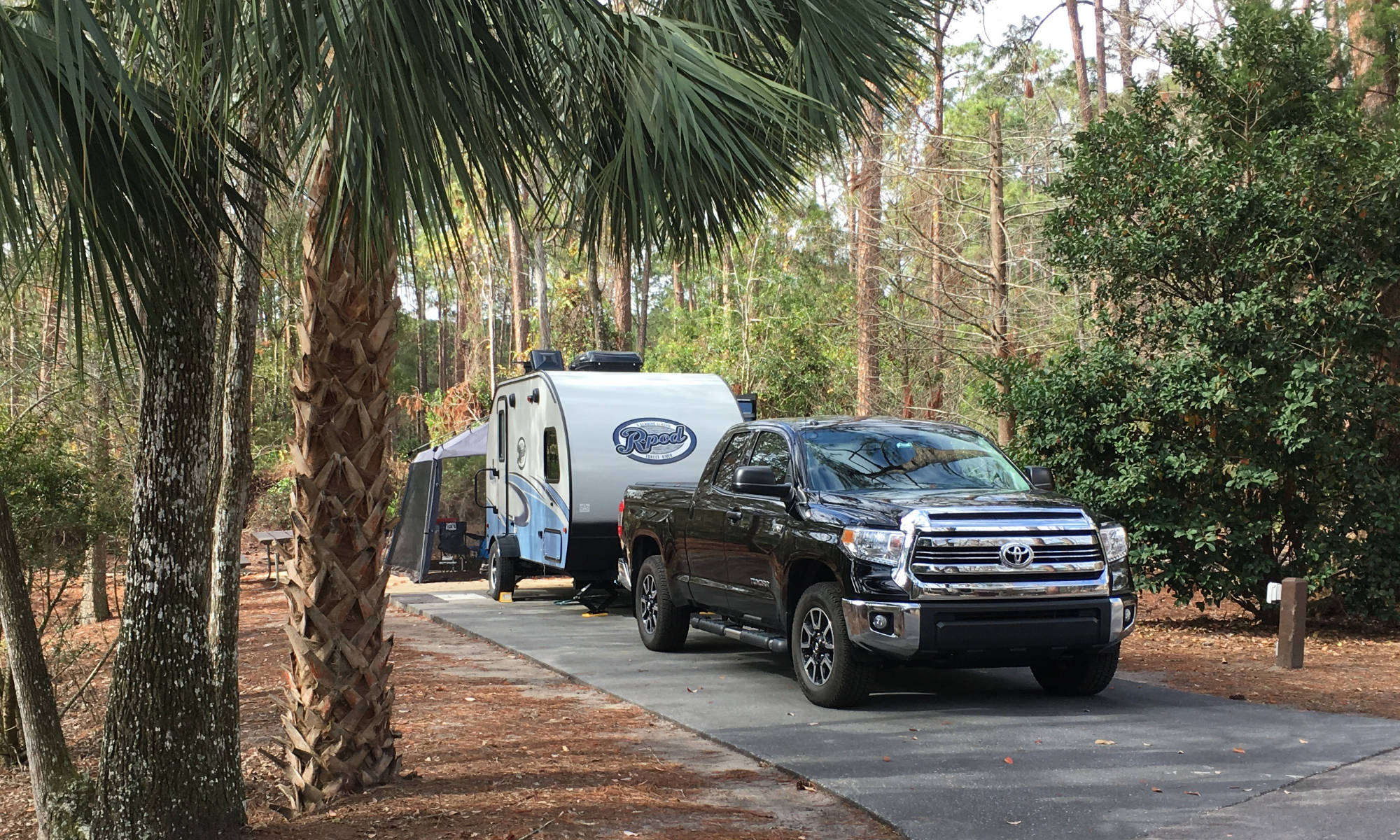In this blog, we’ll cover the latest RV and travel data news. November 2024 RV production numbers are out, and we’ll cover the latest travel data so you can better gauge if it’s time to buy, sell or hold an RV. Later in the news, we’ll discuss the latest developments on recent motorhome regulations and look at a possible game-changer EV travel trailer just released. I’m John Marucci; let’s get started with the news.
RVIA Numbers
On December 24th, 2024, the RVIA posted the latest RV wholesale shipment data for November 2024. Production decreased compared to the prior year, with 23,573 total RVs shipped in November, down 1,587 or 6.31% from November 2023. November 2024 was the lowest production for any November since before 2016. Travel trailer production decreased year-over-year, with 16,698 shipped in November 2024 vs. 17,121 a year ago (a 2.5% decrease).
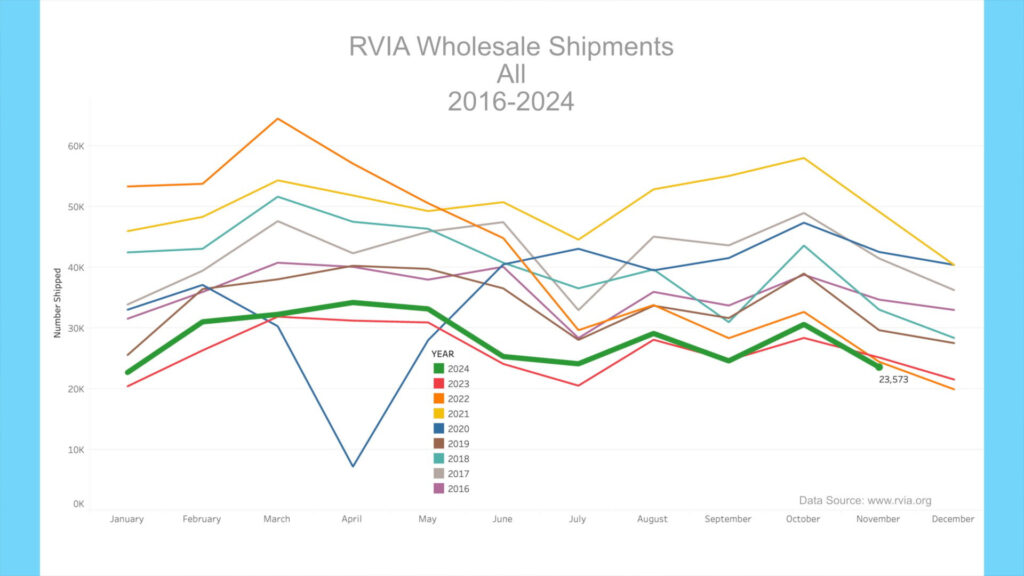
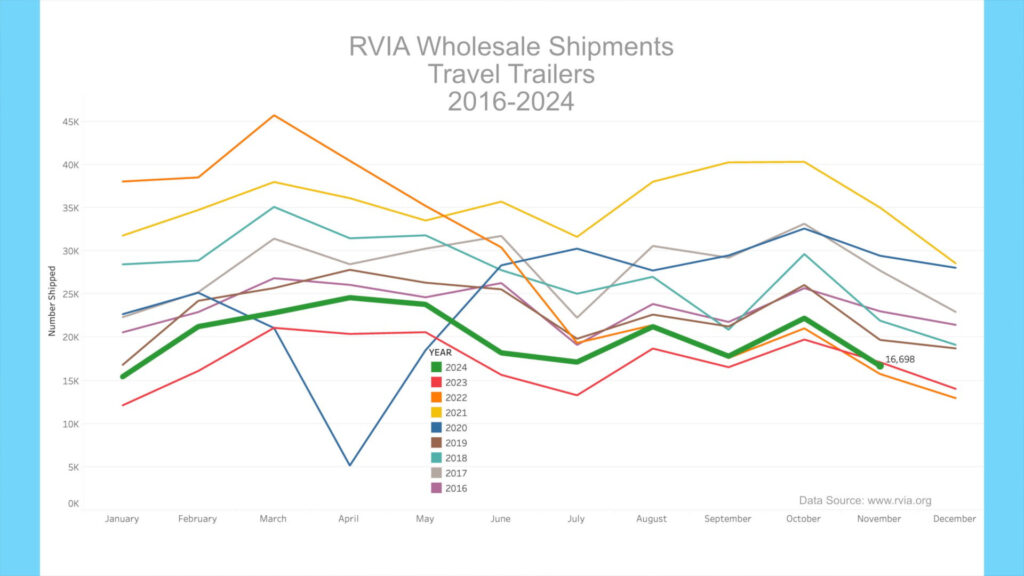
Unfortunately, the bad news continued for motorhome shipments. Motorhome shipments, which include Class A, B & C motorhomes, witnessed its lowest November since before 2016, with only 2,802 units shipped, down 929 or 24.9% from November 2023.
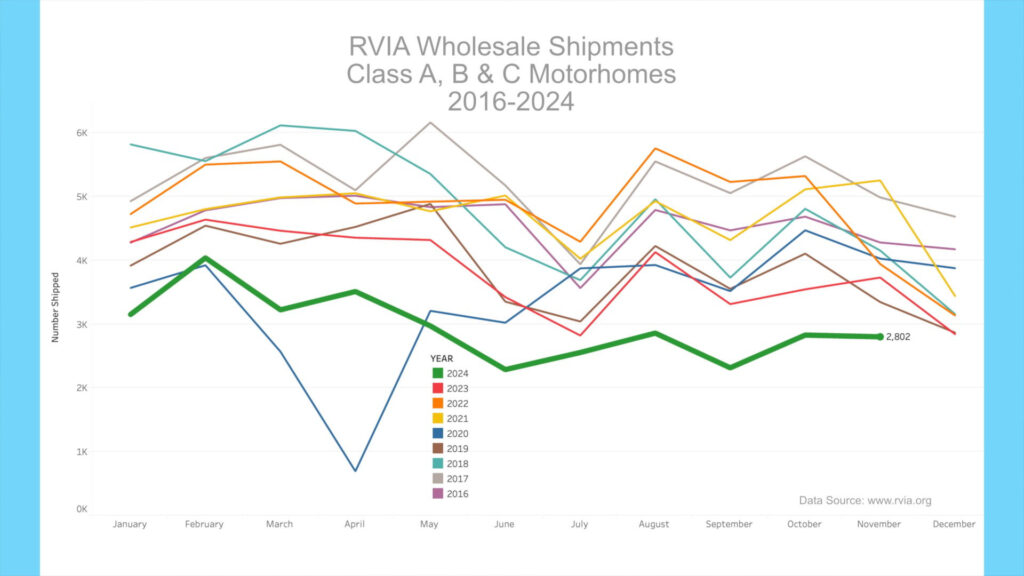
RV Trader Numbers
Meanwhile, RVs for sale on RVTrader.com have increased since last month, with 118,774 new RVs for sale as of January 1st, 2025. This is up by 2,347 units from late November 2024 and down 5,073 or 4.1% compared to a year ago.
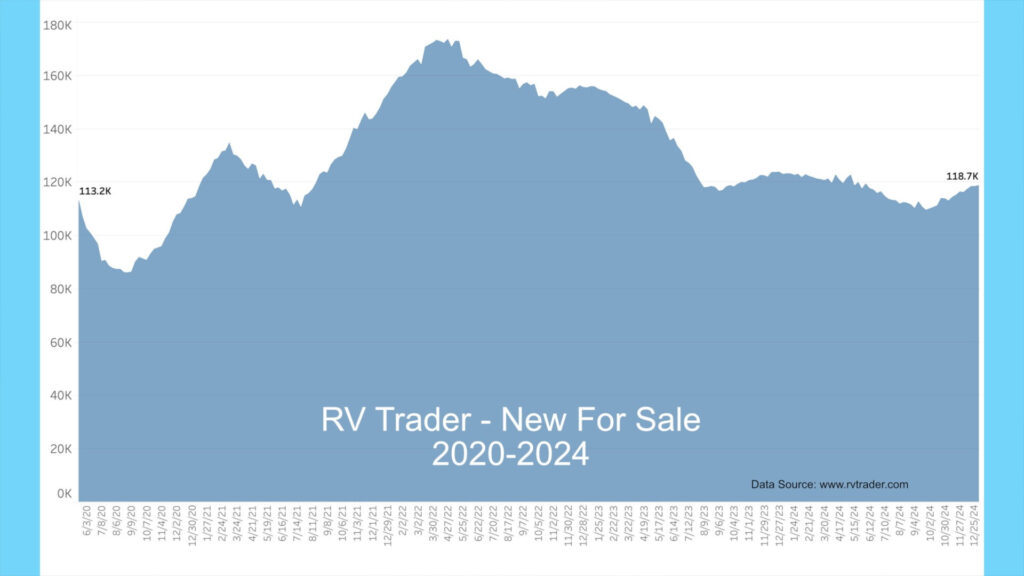
Used units have decreased since last month, with 71,801 used RVs for sale as of January 1st. This is down by 2,081 units from late November 2024 and up by 13,293 or up by 22.7% compared to a year ago. This continued record level of used RVs for sale is evidence of the continued shedding of pandemic trailers by recent RV buyers. Of the 71,801 used units for sale, 30,271, or 42.3%, were built pre-2020, and 37,329, or 52.2%, were built between 2020 and 2023.
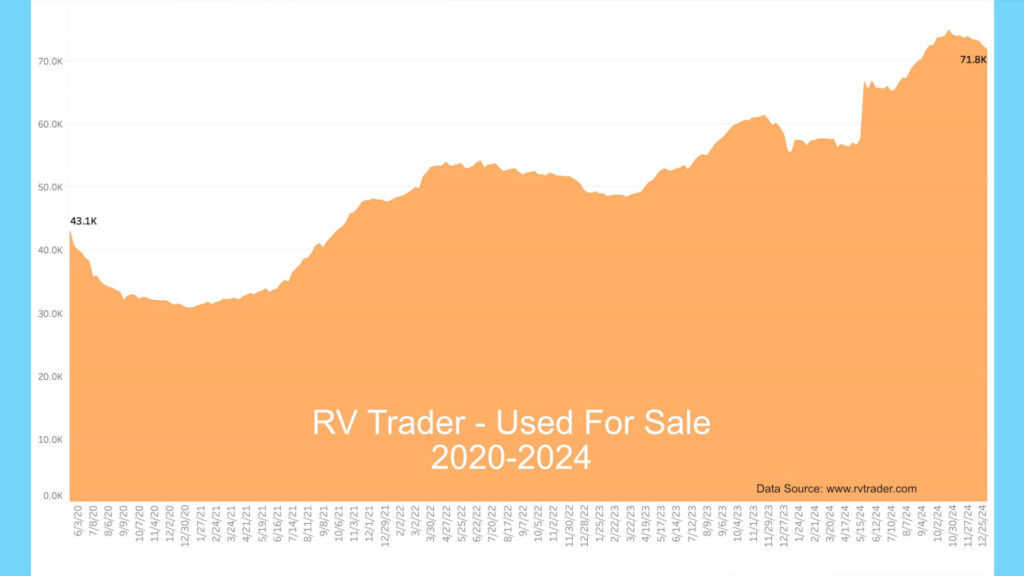
Our model year chart shows new model volumes for 2022 through 2025 since May of 2023. As dealers unload the older units, 2022 models, as indicated by the blue line, have decreased from 39,100 to 1,317 units. The orange line shows 2023 models going from 93,797 to 4,868 units since late June 2023. Meanwhile, the red line shows 2024 models on RVTrader.com. In late June 2023, there were 8,238 new 2024s, and now there are 32,847, having peaked this past summer and running off quickly. Also, 2025 units, as shown by the teal line, are ramping up. There are currently 79,548 units for sale, increasing by 7,639 since late November.

When we look at the model year data by number of weeks on market, surprisingly, we see that 2025’s (teal line) is ramping up quicker than 2024’s (red line) at the same number of weeks on market. Also, the 2024s are falling off faster than the 2023s (orange line). The 2024 model year looks like a historically low production run that ended about four or five months ago. My opinion is that the industry has been overproducing 2025 models for some unknown reason.
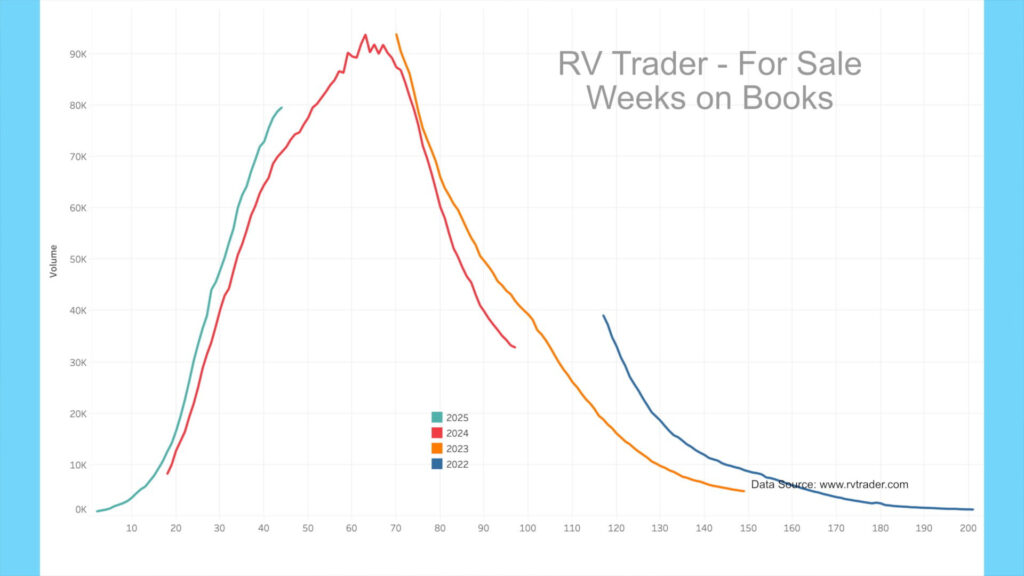
As a reminder, many but not all dealers advertise on RVTrader.com to sell inventory. It remains an excellent proxy for overall dealer inventory. You can follow my account on X at @JohnMarucci to receive weekly updates on this data.
High-End Market – Colonial Airstream
For the high-end market, inventory levels for Colonial Airstream in Millstone Township, New Jersey, the nation’s 2nd largest Airstream dealer, still show a glut of in-stock units.
As of January 1st, Colonial currently has 127 new units on the lot for sale, with 17 spoken for. They have lowered their order book, which now stands at only 26 (vs. 47 in late November and 69 in late October). This time last year, they had double the units (52) in their order book. Their order book has decreased sharply over the past few months as they seem to be quickly pausing new orders.
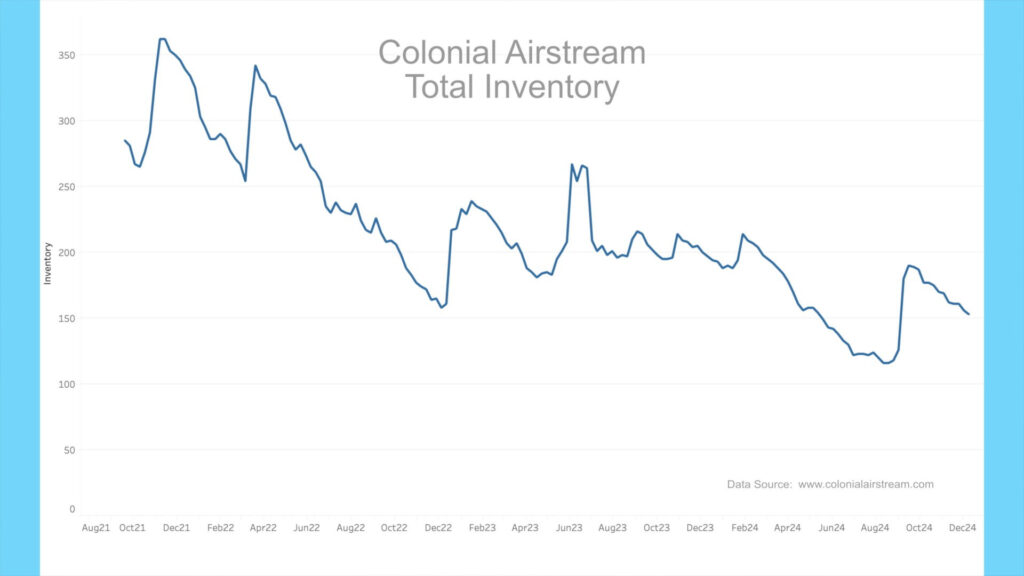
BLS RV Manufacturing Labor Stats
The Bureau of Labor Statistics revised October 2024 manufacturing employment data for Elkhart County, Indiana. The October 2024 manufacturing employment level remained steady from September at 62,300, continuing its sub-2016 level. The BLS is forecasting manufacturing employment to decline slightly in November of 2024.
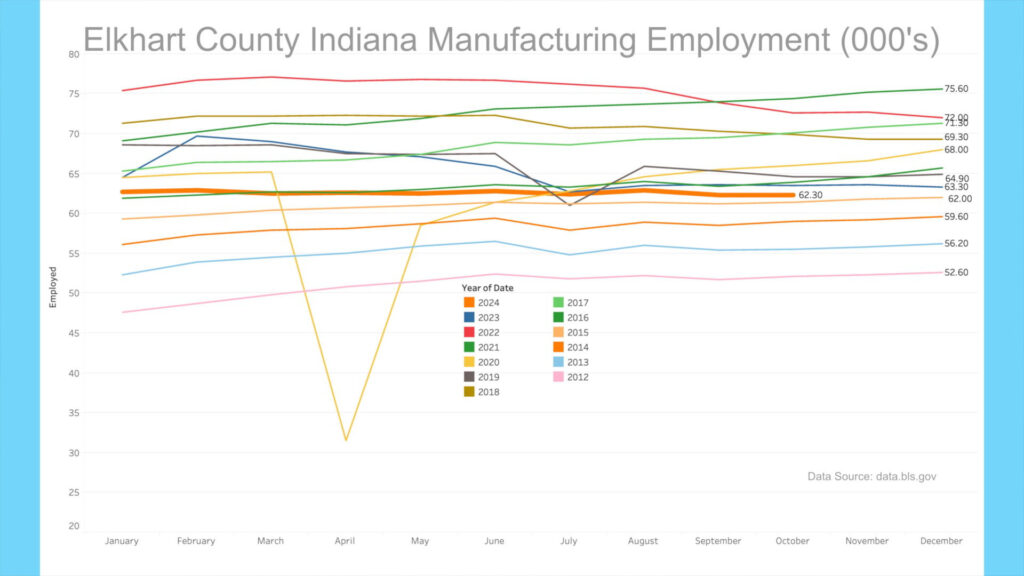
AAA
Gas prices have increased slightly in the past month. According to AAA, the current average nationwide price as of January 1st was $3.062 per gallon for regular unleaded, up about a penny from a month ago and down 4.8 cents from a year ago. An RV trip of 3,000 miles at 10 mpg would cost $919 now vs. $933 a year ago, a 1.5% decrease. Diesel prices have decreased in the past month and currently sit at $3.513 per gallon, down 2.9 cents from a month ago and down about 47 cents from a year ago. A similar 3,000-mile trip getting 12 mpg would cost $878 now vs. $996 a year ago, an 11.8% decrease.
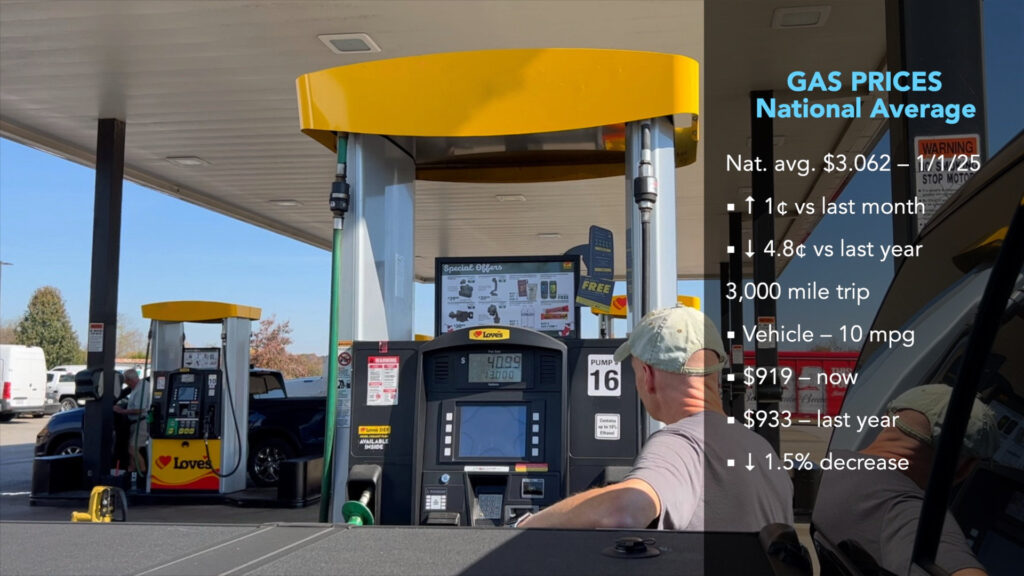
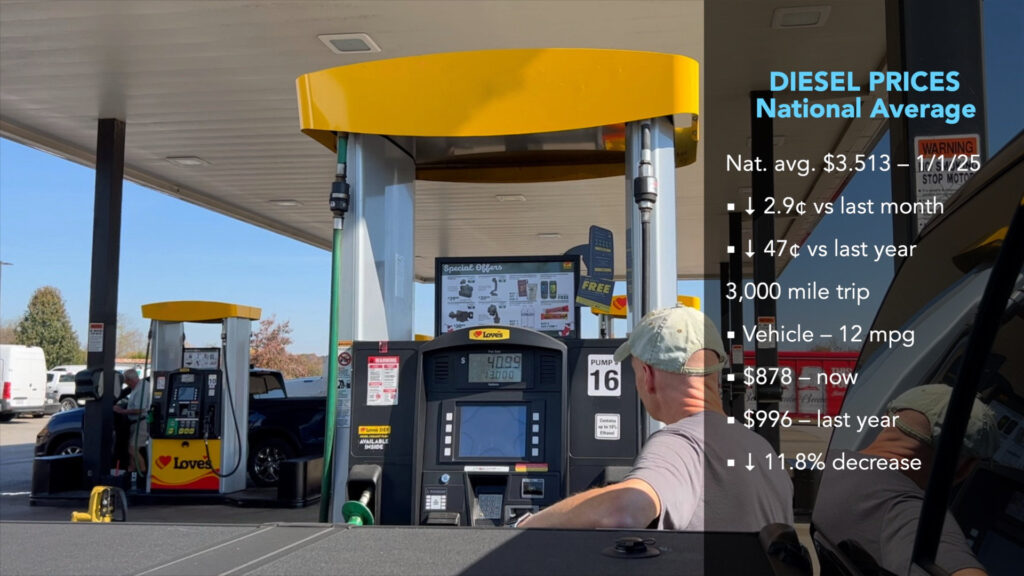
California Motorhome Regulation Update
In November’s newscast, we went in-depth on the California clean air regulation on motorhomes. I won’t repeat the information, so if you want more background, feel free to watch November’s newscast.
The latest update is that since we reported, Oregon has postponed the implementation of the CARB regulation for a year. Oregon Department of Environmental Quality transportation strategy section manager Rachel Sakata said those rules are being delayed for a few reasons, including the limited number of medium- to heavy-duty engines available that qualify under those emissions standards.
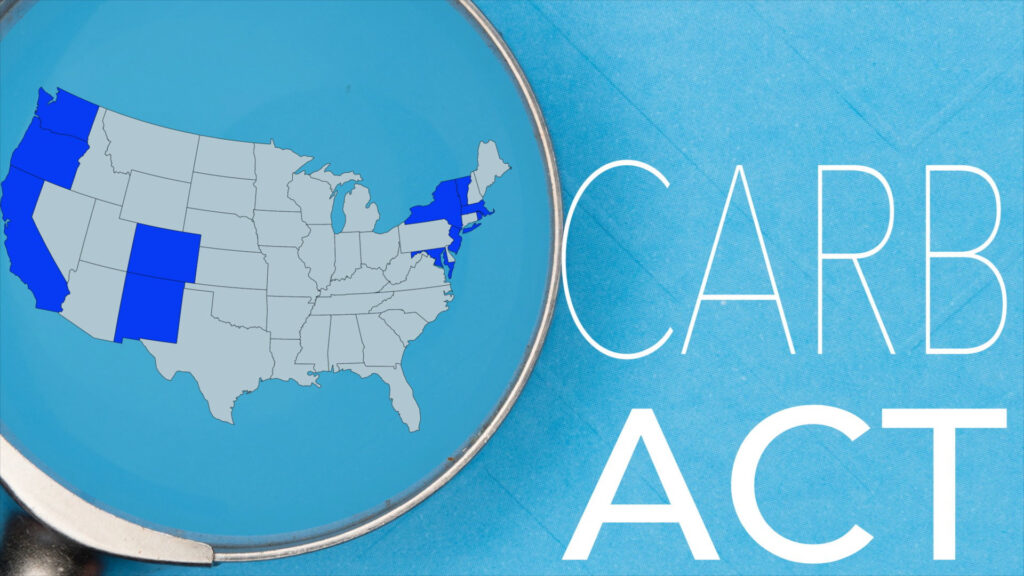
“We’ve been talking with the manufacturers, and we understand that there’s going to be very few compliant engines available in the market in 2025,” Sakata said. “What that means is that manufacturers are not offering any new vehicles for sale because they have very few of those engines available.”
While the rules require manufacturers to sell between 7% to 11% of their trucks as zero-emission vehicles, the rules do not prohibit them from selling diesel vehicles, Sakata said. “They can still continue to sell as many diesel vehicles as they want,” she said. “They just have to make sure that they do sell a certain percentage of zero-emission vehicles.”[1]
Oregon Trucking Association President A said she was informed there were fewer than ten 18-wheeler zero-emission trucks sold in the state in 2023. “They don’t haul as much product, they cost three times as much, and they only go a couple hundred miles, and there is only one public charging station in the entire state. So there’s just no infrastructure to support the transition to zero-emission vehicles today in Oregon.” Jarvis worries that the rules will make people hold on to their trucks longer instead of buying a zero-emission truck.[2] The last sentence is a real insight: compliance may cause truckers to hold onto their existing vehicles longer, making the roads less safe over time.
According to RV Business, “Motorhomes can still be sold either through utilizing the credit market or generating a carry-forward deficit that will have to be offset by the chassis manufacturer credits within three years.” RV chassis makers will have to pay more for the privilege of selling ICE chassis in California, which will drive the cost up to consumers.[3] It will be interesting to see if manufacturers pay for credits to sell into these markets or back off. It will likely cause an arbitrage situation as the prices of motorhomes in California will be much higher than in some neighboring states. Someone shady will likely figure a way around it if prices differ wildly.
Something New – The Lightship EV RV – AE.1 Cosmos
How about starting the new year with something new to the RV World? Lightship RV has a new EV travel trailer that just might check all the boxes. Lightship RV, out of Broomfield, Colorado, a Denver suburb, on December 11th, put its new AE.1 Cosmos EV trailer on sale to the public. Assuming that many of you are as skeptical of an EV RV as I am, I decided to dig a bit deeper into the specs of this model to see how it fares. To me, the big question is about range and towability.
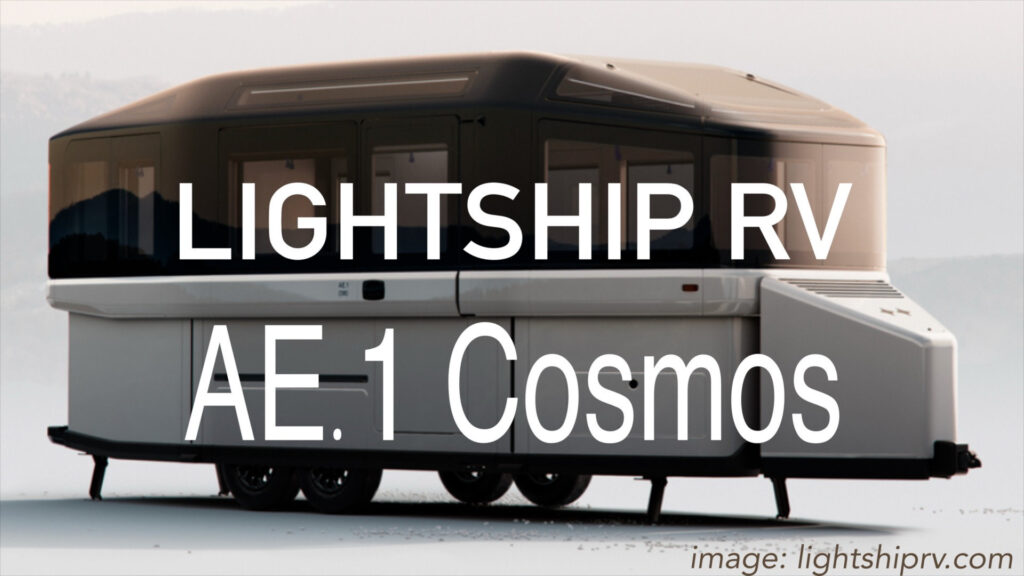
With the new Lightship AE.1 Cosmos, they are advertising a 300-mile range. We are talking about a fully electric travel trailer that will still need to be towed, so it is not a self-contained motorhome. The benefit in terms of range is that the large battery can assist the tow vehicle when in transit. Lightship calls this TrekDriveTM. The trailer’s batteries drive the trailer’s axles in synchronicity with the tow vehicle, removing load from the truck.
If you are towing with a Tesla Cybertruck EV, for example, the promise is that you would lose no range on the truck when towing. So, instead of a huge range decline for the tow vehicle while towing, you can now get the truck’s full stated distance on a charge. This is a big deal because now you don’t have to stop for 250+ miles to recharge batteries.
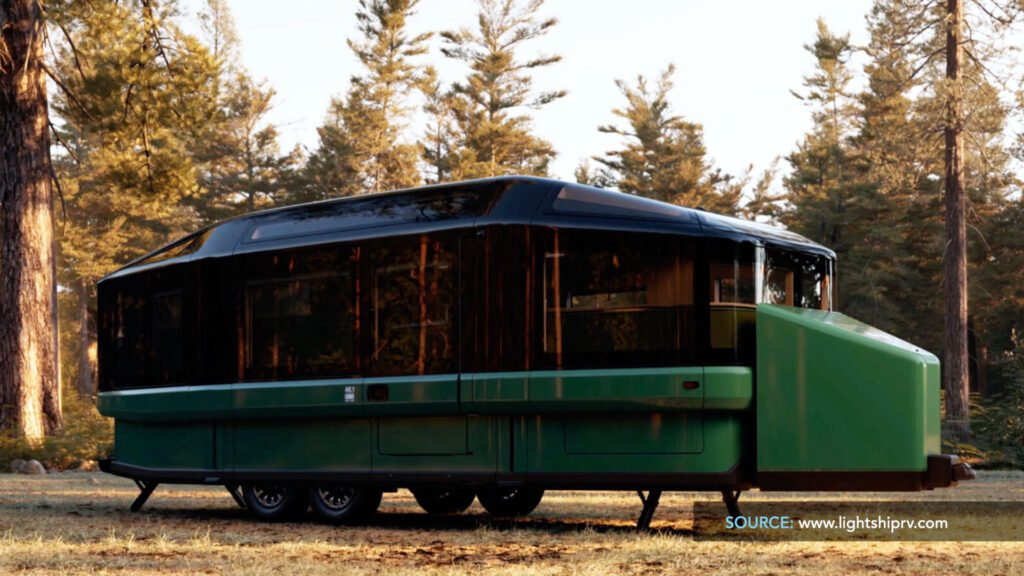
The company also touts that the unit can be towed with a non-EV truck. This is the bigger deal since most people who tow with a truck have no plans to pay six figures for another truck (EV or otherwise) while their current truck works fine. So, why would an all-electric trailer be a real upgrade? Let’s look at my situation.
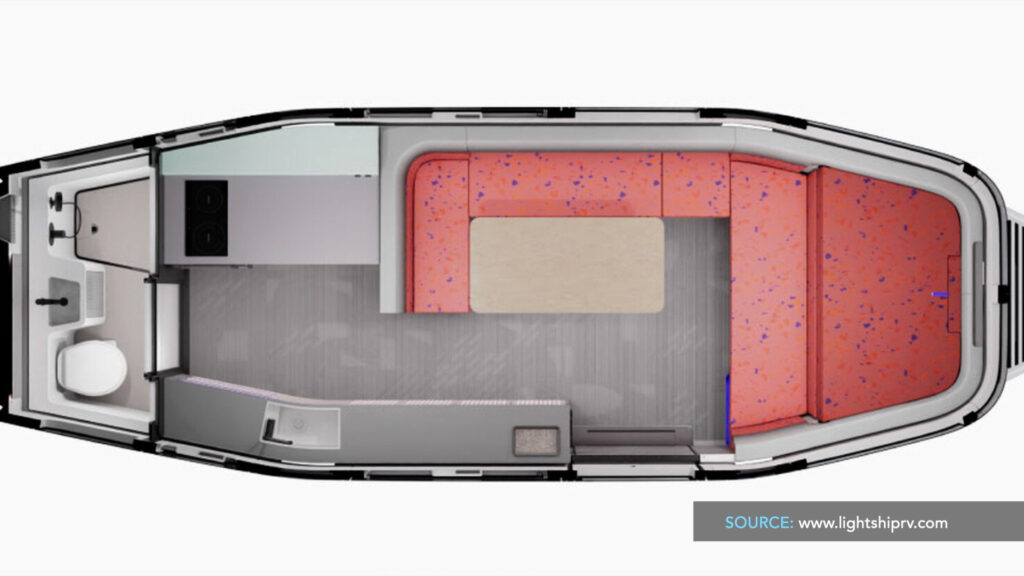
I get about 17 mpg highway in my 2017 Toyota Tundra when not towing and just under 10 mpg (9.6 mpg) when towing my 5,000 lb. (unloaded weight) 2020 Keystone Bullet travel trailer. If my trailer were self-propelled, it would take load off the Tundra and, in theory, would raise my gas mileage while towing. This is what should happen with an EV trailer when driven with an ICE vehicle. I have yet to confirm this functionally with the company, but my guess from their marketing material is that this is the case. My Tundra may get 14 mpg while towing with the AE.1, which would mean a $300 savings on gas for a 3,000 trip.
Unfortunately, in the first scenario, where I have a Cybertruck and the new Lightship AE.1, I could get as much as 300 miles down the road, but when I stop at a supercharger, I now have to charge my EV truck and my EV trailer. One problem I’d likely run into is how to charge the trailer at a supercharger while on the road, as most are made for cars and not larger trailers. So, public charging infrastructure in tight parking lots may be an issue.
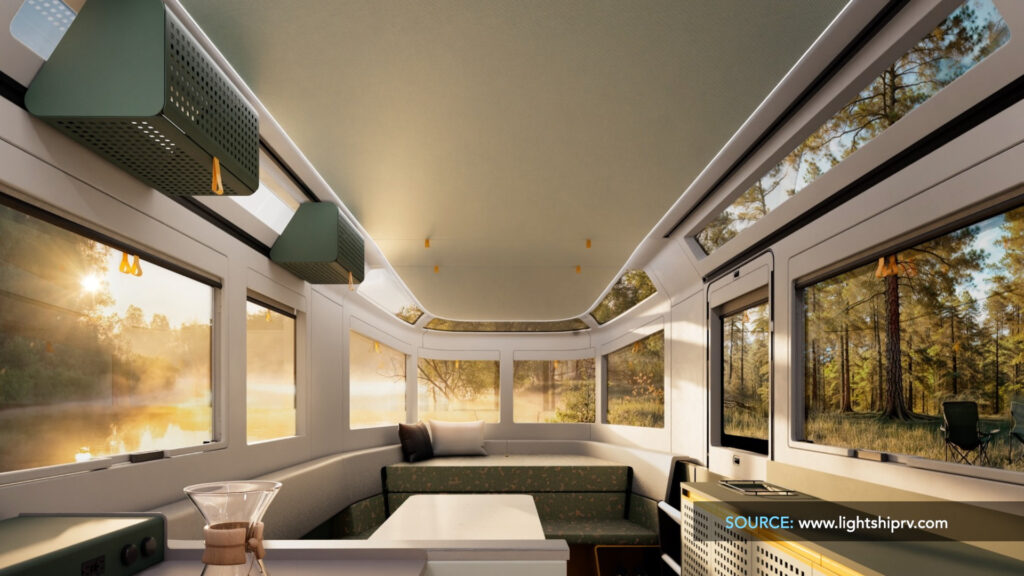
With my Tundra, I could add a DC to DC charger under the hood of my Tundra to send considerable amperage back to the trailer’s batteries while in transit. At least, I hope it would be wired this way so I can arrive at the campsite with the trailer’s batteries somewhat charged. I would still have to stop and charge the trailer while on long trips (or tow without TrekDriveTM)[4], but now we only charge one, not two vehicles. Again, I still need to verify with the company that the ICE vehicle would have TrekDriveTM to help out the truck while in transit and that charging from the truck to the trailer while in transit would work.

Another sticky point is the power draw at campsites. The new AE.1 comes with an impressive 1,800 watts of solar, and they claim that you can subsist off-grid for quite an impressive time and run all appliances. Yet, I’d imagine these EV trailers would be mainly used where there is shore power at local state parks or private campgrounds. My point is that many campsites have, let’s say, less-than-great electrical service, where a hot day with lots of RV ACs running will cause a power outage.
So, if we plug in a few of these large draws to the outdated electrical service at many campgrounds, how will it impact the experience of others, not to mention the power bill of the campground? I can see the signs already saying at private campgrounds, “No Charging EVs – that Means You!”
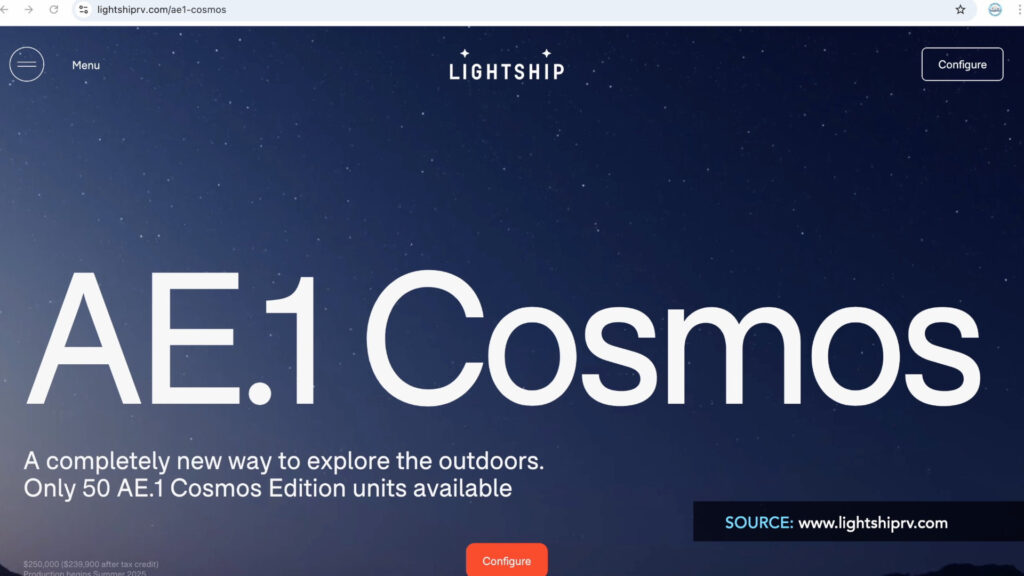
I’ll put a link in the description to Lightship’s website so you can explore what looks to be a beautiful and well-designed EV trailer. From what I’ve seen, they could remove the batteries, and it would immediately become one of the best trailers built; it’s that beautiful. The specs are also outstanding, with a manageable towing and tongue weight, outstanding tank sizes, good storage solutions, and a nice way to do a trailer bathroom. It is just a great-looking trailer, EV or not. I have yet to investigate the materials used on the structure, sub-flooring, and walls, but they appear to be composite materials all around.
I hope to do a deeper dive into the model in the new year and have several of my questions answered.
That should do it. All the best in your camping adventures!
As always, thanks to our fans who support our efforts by starting their shopping from our Amazon Storefront and their generous financial support by using the THANKS feature located under each YouTube video ($ within the Heart icon). Your support is greatly appreciated!
1. https://www.opb.org/article/2024/11/27/oregon-to-temporarily-delay-zero-emission-trucks-rules/ ↑
2. ibid.
3. https://www.rvnews.com/multiple-regulatory-deadlines-approach-in-2025/
